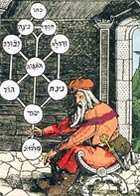It's Magic

"Spirituality," a key phrase of our time, suggests a yearning for contact with an ungraspable realm beyond earthly experience. Yet for most of history, the spiritual realm was deemed eminently graspable indeed—as is evidenced by a fascinating exhibit now in Jerusalem.
The exhibit abounds in amulets of all kinds—on stone, metal, parchment, textiles, and in print—meant to ward off scorpions, demons, and nightmares, to protect newborns, and to elicit love and success. Along with them are magic bowls, inscribed with incantations, intended to catch demons at the door; volumes of instructions for casting spells; and an array of items designed to ward off the evil eye (ayin ha-ra). The various elements and purposes of magic in Jewish life come together in the ubiquitous hamsa: the representation of a hand, often with an eye in the center, ringed about with biblical verses. Originating in ancient Phoenicia, the hamsa migrated to Muslim and thence to Jewish communities, its symbolism resonating with the outstretched hands of the priestly blessing (Numbers 6:22-27) and the association of the fifth letter of the Hebrew alphabet, heh, with the Name of God.
Throughout the ages, magic—and astrology—put doctrinal Jewish norms to the test. Biblical law robustly prohibited sorcery, but over time the prohibition was interpreted as referring narrowly to black magic—i.e., the offensive use of such sorcery—while white magic, deployed against the dark forces, was not forbidden. Maimonides famously dismissed astrology as idolatrous nonsense, equating the angels populating the Hebrew Bible with the separate intellects of Aristotelian metaphysics. Others, like Nahmanides, saw magic as an efficacious but dangerously Promethean interference with the divinely-mandated order. Many kabbalists incorporated both magic and astrology into their view of the universe as a vast arena of contending energies, to be navigated and sometimes mastered via prayer, mediation, and ritual.
In recent centuries imaginations have been gripped by two denizens of the magic realm: the golem and the dybbuk, each in its own way highlighting the power struggle between matter and spirit. The advent of New Age and popular kabbalah has seen a surge in amulets, ribbons, and talismans. In 1996, Israel's Shas party scored its greatest electoral victory after distributing 100,000 amulets, mass-produced in China, blessed by a nonagenarian kabbalist, and promising divine success to Shas voters.
The illusions of magic are grounded in very real human terrors: misfortune, illness, loss. Modern psychology and the social sciences provide explanations, but cannot guarantee protection. Neither can the austere rationalism of Maimonides. Deliverance from fear is religion's largest promise. Those who eschew the magical version of that promise must find other means, lucid, responsible, and persuasive, for offering the same modicum of hope.
Comments are closed for this article.




